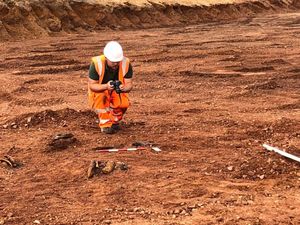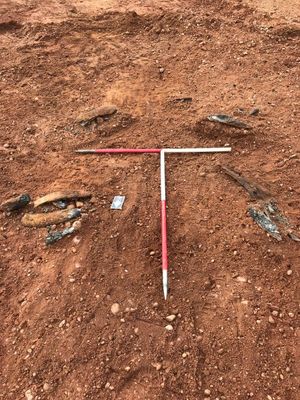Woolly mammoth’s tusk found in Staffordshire quarry
Mammoth tusk remains have been found in a quarry by a team of archaeologists.

Experts from the Worcestershire Archive and Archaeology Service uncovered the fragments at the Whitemoor Haye quarry, near Alrewas, in Staffordshire.
The remains, which are believed to date back around12,000 years, were found two days before a new exhibition was due to be launched at The Hive library in Worcester.
A member of the Worcestershire Archive and Archaeology Service team took to social media to say: “The feeling when you find more bits of woolly mammoth two days before the launch of your major new Ice Age exhibition.
"What is the record for getting something from site into an exhibition?”

The fragments were found by a quarry worker on the Tarmac operated site.
Rob Hedge, who worked to bring the remains to the Ice Age exhibition at the library, said the find was ‘really exciting’.
Mr Hedge, of the Worcestershire Archive and Archaeology Service, said: “The tusk fragments were found on the Whitemoor Haye Quarry, near the National Memorial Arboretum in Staffordshire.
“The quarry is operated by a company called Tarmac. The discovery is close to where last month we found a woolly mammoth radius, which is the leg bone.
“The tusk is very fragmented. It was found quite deep in the gravel. One of the quarry workers found the tusk with the edge of his bucket.
“We had to clean around it and photograph it. It then got packed with water into bags and came back to the office.
“Then it got dried out very slowly – if you do it too quick it can cause it to fall apart.
“It is really exciting. We have had more complete tusks from this region but what is interesting about this one is even though it is in bits we are able to see the structure of the tusk and it is quite small
“This is likely to be in the later period of the mammoth.”
It is one of many finds made across the West Midlands recently – with another set of bones discovered along the River Tame in Staffordshire last month.
The bone found was believed to have been the elbow or lower front leg bone of a woolly mammoth.
The fragments are on show in ‘Lost Landscapes: The story of the Ice Age’ at The Hive until September 8.





